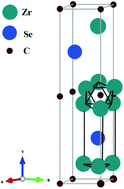Newly synthesized MAX phase Zr2SeC: DFT insights into physical properties towards possible applications†
Abstract
A DFT study of the synthesized MAX phase Zr2SeC has been carried out for the first time to explore its physical properties for possible applications in many sectors. The studied properties are compared with prior known MAX phase Zr2SC. The structural parameters (lattice constants, volume, and atomic positions) are observed to be consistent with earlier results. The band structure and density of states (DOS) are used to explore the metallic conductivity, anisotropic electrical conductivity, and the dominant role of Zr-d states to the electrical conductivity at the Fermi level. Analysis of the peaks in the DOS and charge density mapping (CDM) of Zr2SeC and Zr2SC revealed the possible variation of the mechanical properties and hardness among them. The mechanical stability has been checked using elastic constants. The values of the elastic constants, elastic moduli and hardness parameters of Zr2SeC are found to be lowered than those of Zr2SC. The anisotropic behavior of the mechanical properties has been studied and analyzed. Technologically important thermodynamic properties such as the thermal expansion coefficient (TEC), Debye temperature (ΘD), entropy (S), heat capacity at constant volume (Cv), Grüneisen parameter (γ) along with volume (V) and Gibbs free energy (G) are investigated as a function of both temperature (from 0 to 1600 K) and pressure (from 0 to 50 GPa). Besides, the ΘD, minimum thermal conductivity (Kmin), melting point (Tm), and γ have also been calculated at room temperature and found to be lowered for Zr2SeC compared to Zr2SC owing to their close relationship with the mechanical parameters. The value of the ΘD, Kmin, Tm, and TEC suggest Zr2SeC as a thermal barrier coating material. The optical properties such as dielectric constant (real and imaginary part), refractive index, extinction coefficient, absorption coefficient, photoconductivity, reflectivity, and loss function of Zr2SeC are computed and analyzed to reveal its possible applications.



 Please wait while we load your content...
Please wait while we load your content...